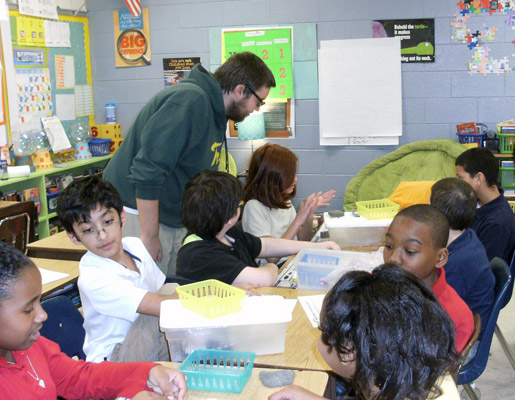Igneous, metamorphic & sedimentary journeys
Geology on Wheels takes earth science concepts out on the road
When Geology on Wheels rolls into an elementary school, the star is usually obsidian—at least as far as the kids are concerned.
“They love obsidian because it’s glass,” says Linda Morse. “And they know that a volcano threw it out in the air.”
Morse is the director of laboratories in William & Mary’s Department of Geology. She also is the current coordinator of Geology on Wheels, which sends teams of geology majors out to introduce young students to the glories and wonders of science in general, and the earth sciences in particular.
Geology on Wheels has visited classes in all grade levels, but Morse said that in recent years the program has been targeting fifth-grade classes.
Taking aim at the SOL
“That’s the big SOL test year,” she explained, referring to Virginia’s Standards of Learning test regimen. This STEM-outreach program continues to evolve to address the earth-science component of the fifth-grade Standards of Learning (SOL) test. SOLs are a series of standardized tests that each Virginia student must take at various points in his or her K-12 career.
 A typical visit from Geology on
Wheels is an hour-long, hands-on event with worksheets and lots and lots of
samples. The subject matter is coordinated with the fifth-grade teacher and
reinforces the lessons taught in the classroom, Morse said.
A typical visit from Geology on
Wheels is an hour-long, hands-on event with worksheets and lots and lots of
samples. The subject matter is coordinated with the fifth-grade teacher and
reinforces the lessons taught in the classroom, Morse said.
“We run a Geology on Wheels session as a laboratory,” she explained. “The first rule of science is, first you observe, then you interpret. The kids use their eyes, using magnifiers to look at the rocks and then they identify and interpret what that rock might be, based on the information we give them.”
Morse said each Geology on Wheels visit supplies plenty of samples, so that there’s a box of rocks for every two or three fifth graders. The program offers a number of lessons, from soils to basic silicate minerals to plate tectonics, Morse said. Along with perennial favorite obsidian, the fifth graders like learning about the fun minerals, such as halite and pyrite.
Smarter than a box of rocks
The teachers, ever-mindful of the SOL content, have their own favorite lessons, Morse said.
“The most requested lesson is the rock cycle,” she said. “You know: igneous, metamorphic, sedimentary.”
The hands-on nature of Geology on Wheels presentations allows the fifth-graders to understand some principles of earth science that go beyond mere igneous, metamorphic, and sedimentary. For instance, they learn to identify rock specimens by color and begin to understand how color can give you clues to the mineralogy of the specimen. In one lesson, the fifth-graders learn to compare crystal size to tell the difference between lava (molten rock emitted from a volcano) and magma (molten rock still in the earth).
Geology on Wheels began more than 20 years ago, a brainchild of Heather Macdonald and Jerre Johnson. Macdonald is now Chancellor Professor of Geology, while Johnson, a professor emeritus, is one of the “founding fathers” of the Department of Geology at William & Mary.
Morse said that Geology on Wheels, in its early days, was a program in which geology faculty helped out at high school classes. The program changed over the years as the SOLs were instituted and Virginia’s elementary-school curriculum incorporated more earth science.
“When I came on, about 20 years ago, it evolved into a program where our majors go out to elementary schools,” she said.
Morse says Geology on Wheels tries to reach as many public- and private-school fifth-grade classrooms as possible in the Williamsburg area. A visit from William & Mary geology students carrying boxes of rocks is as welcome among fifth-grade students as it is their teachers, she added.
“It’s a plus-plus for everybody. The
students are thrilled to have William & Mary scientists in their
classroom,” Morse said. “The teachers are thrilled, because our majors can
clear up questions that they have about the science.” ![]()















